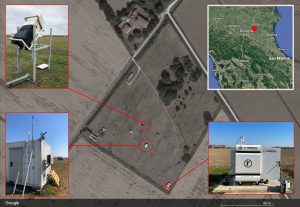IDEAS-QA4EO project WP 2250-2251 “DOAS-BO: Towards a new FRM4DOAS site in the Po valley"
 The main purpose of the Instrument Data Quality Evaluation and Analysis Service – Quality Assurance for Earth Observation (IDEAS-QA4EO) project WP 2250-2251 “DOAS-BO: Towards a new FRM4DOAS site in the Po Valley” is the creation of the first Italian Multi AXis – Differential Optical Absorption Spectroscopy (MAX-DOAS) measurement site compliant to the Fiducial Reference Measurement for DOAS (FRM4DOAS) requirements. This goal is achieved by exploiting the SkySpec-2D ground-based MAX-DOAS instrument, developed by Airyx and acquired* by the Italian research institute Consiglio Nazionale delle Ricerche – Istituto di Scienze dell’Atmosfera e del Clima (CNR-ISAC).
The main purpose of the Instrument Data Quality Evaluation and Analysis Service – Quality Assurance for Earth Observation (IDEAS-QA4EO) project WP 2250-2251 “DOAS-BO: Towards a new FRM4DOAS site in the Po Valley” is the creation of the first Italian Multi AXis – Differential Optical Absorption Spectroscopy (MAX-DOAS) measurement site compliant to the Fiducial Reference Measurement for DOAS (FRM4DOAS) requirements. This goal is achieved by exploiting the SkySpec-2D ground-based MAX-DOAS instrument, developed by Airyx and acquired* by the Italian research institute Consiglio Nazionale delle Ricerche – Istituto di Scienze dell’Atmosfera e del Clima (CNR-ISAC).
The first stage of the project consisted of the assessment of the SkySpec-2D’s performance. This target has been pursued through two measurement campaigns, one against the TROPOspheric Gas Analyser Spectrometer (TROPOGAS), a custom-built MAX-DOAS instrument owned by the CNR-ISAC, and the other one against the Pandora#117, a reference instrument installed at the Boundary layer Air Quality-analysis Using Network of Instruments (BAQUNIN) super-site in La Sapienza University (Rome). Since October 2021, the SkySpec-2D has been installed at its permanent position at the “Giorgio Fea” observatory, where it is continuously measuring MAX-DOAS Visible (VIS) and Ultra-Violet (UV) diffuse solar spectra.
As shown in the figure, the “Giorgio Fea” observatory (https://www.isac.cnr.it/it/node/7803, Latitude: 44.65° N, Longitude: 11.62° E, Altitude: 11 m a.s.l.) is located at the rural site of San Pietro Capofiume – Bologna, Italy (SPC). The site, founded in the early 1980s, is managed by the Agenzia Regionale per la Prevenzione, l’Ambiente e l’Energia (ARPAE) of Emilia Romagna, while CNR-ISAC operates in the field under the umbrella of a long-term agreement with ARPAE. The station is equipped for in-situ monitoring of trace gases and particulate matter sampling. ARPAE also runs radar measurements and radio soundings. The station is part of the European Research Infra-structure ACTRIS. Currently, a MAX-DOAS instrument (below left of the figure), an Automatic LIDAR/Ceilometer (top left of the figure) and a CIMEL CE318-T which is part of the AErosol RObotic NETwork (AERONET) are operating on the site. Moreover, a Raymetrics LIDAR (below right of the figure) is in the setting up phase.
The MAX-DOAS spectra are useful to infer information on trace gases concentrations that absorb VIS and UV radiation, such as nitrogen dioxide (NO2), ozone (O3), water vapor (H2O), formaldehyde (HCHO), glyoxal (CHOCHO) and sulphur dioxide (SO2). In particular, zenith spectra provide information on the total Vertical Column Densities (VCDs), while off-axis spectra are particularly suitable to retrieve vertical profiles in the lower part of the troposphere. Since the “Giorgio Fea” observatory is located far away from important local emission sources and the acquired spectra fully meet the FRM4DOAS standard requirements, these measurements are particularly suitable to validate satellite data. Moreover, they are representative of the background level of pollution in the Po Valley, allowing to perform air quality studies in one of the most polluted regions in Europe.
* Project “Sviluppo delle Infrastrutture e Programma Biennale degli Interventi del Consiglio Nazionale delle Ricerche – Potenziamento Infrastrutturale: progetti di ricerca strategici per l’ente. Progetto 32—ASSE NORD Pianura Padana Mt. Cimone, Bologna, San Pietro Capofiume”



